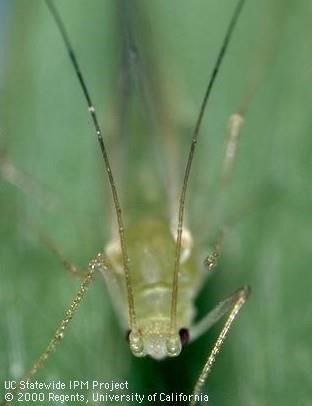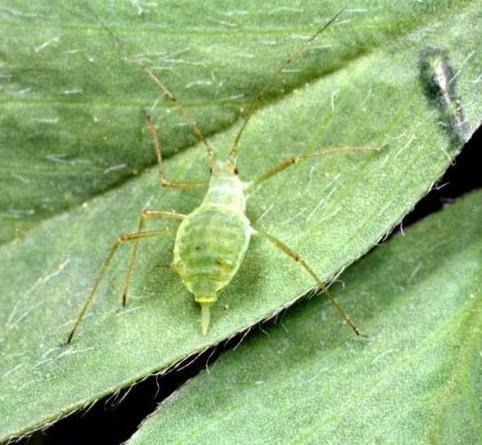| Common name | Size and color description | Population peak |
|---|
| Blue alfalfa aphid | 3/16"; blue with black cornicles | March - June |
| Cowpea aphid | 1/8"; shiny black with black cornicles | April |
| Pea aphid | 1/4"; pale green or pink with dark cornicles | April - November |
| Spotted alfalfa aphid | 1/8"; pale yellow with dark spots on the abdomen and short cornicles | May - October |
Blue alfalfa aphid. The blue alfalfa aphid can be found throughout the United States, but is not commonly found in Iowa alfalfa. Often blue alfalfa aphids and pea aphids are intermingled on plant stems, but can be distinguished with a few common characters. Blue alfalfa adults are 3/16 inches in length and bluish-green in color. Blue alfalfa aphids can be dull or waxy and have uniformly dark antennae, compared to shiny pea aphids with dark antennal bands. Blue alfalfa aphids are most productive during spring and early summer due to mild weather conditions; these aphids begin to decline when temperatures exceed 90˚F. Colonies prefer to feed on newly expanding leaves, but will move down to stems as the leaves mature and become crowded.
 Blue alfalfa aphid. (Photo by Jack Kelly Clark, www.ipmimages.org)
Blue alfalfa aphid. (Photo by Jack Kelly Clark, www.ipmimages.org)
Cowpea aphid. The cowpea aphid is common throughout the United States and Mexico and is becoming more common in Iowa alfalfa. This small aphid is less than 1/8 inches in length, and is easily distinguished from other aphids in alfalfa because the adults are shiny black and the nymphs are dull grey. The base of cowpea aphid antennae is white, but gradually darkens toward the tip, and the legs are white with dark “feet.” Colonies prefer feeding on newly expanding leaves, but cluster on leaves, blooms and stems. These aphids are most successful during early spring or late fall, and begin to decline when temperatures exceed 75˚F. Cowpea aphids transmit a toxin while feeding that can cause wilting and discoloration of alfalfa, and heavy infestations (>100/stem) can cause severe stunting, dieback or death.
 Cowpea aphid. (Photo by Whitney Cranshaw, www.ipmimages.org)
Cowpea aphid. (Photo by Whitney Cranshaw, www.ipmimages.org)
Pea aphid. The pea aphid is found throughout North America and is the most common species in Iowa alfalfa. Adults are 1/4 inches in length, and body color ranges from light green to yellow, or pale pink. In addition to their relatively large size, pea aphids can be distinguished from other aphids by the dark bands of color on the antennae. Pea aphids are in alfalfa the entire summer, but reproduction is dramatically slowed down when temperatures exceed 90˚F. Colonies prefer to feed on stems and newly expanding leaves. Pea aphid feeding may turn leaves yellow and stunt overall plant growth when present in moderate numbers (50-100/stem).
 Pea aphid. (Clemson University, www.ipmimages.org)
Pea aphid. (Clemson University, www.ipmimages.org)
Spotted alfalfa aphid. The spotted alfalfa aphid is found throughout the United States and is occasionally found in Iowa alfalfa. The spotted alfalfa aphid is smaller than pea aphid, reaching 1/8 inches in length. This aphid is also distinguished because it is pale yellow with dark spots covering the abdomen. Unlike the pea aphid or blue alfalfa aphid, the spotted alfalfa aphid can successfully reproduce in warm temperatures (> 90˚F). Colonies prefer to feed on the lower portions of alfalfa, including stems, petioles and leaves. Spotted alfalfa aphids transmit a toxin while feeding and can cause early leaf drop, distinctive vein-banding or chlorosis.
 Spotted alfalfa aphid. (Kansas Department of Ag, www.ipmimages.org)
Spotted alfalfa aphid. (Kansas Department of Ag, www.ipmimages.org)
Aphid Scouting and Thresholds
Aphids excrete a sugar-rich honeydew that can promote sooty mold and potentially reduce photosynthesis. Heavily infested plants will be discolored and stunted. Some aphids are capable of vectoring plant diseases via persistent or non-persistent transmission. Those species that vector disease are considered more economically important because even low aphid densities can reduce quality and yield. This short video from UC IPM shows how to scout and identify aphids found in alfalfa.
Although aphids are considered secondary pests in alfalfa, sometimes they surpass treatment guidelines (Table 2). Scouting for aphids in alfalfa is relatively easy, and can be estimated by sweep netting or direct stem counts. Fields should be scouted weekly, especially in the spring and early summer. Count aphids on at least 30 stems and estimate the average number per stem. For large fields, consider sampling multiple areas to ensure complete coverage of the field.
There are options to consider before using insecticides. Biological control, the use of resistant cultivars, and harvesting will often minimize aphids to tolerable levels in most cases. Fortunately, there are many different natural enemies to aphids. For those fields with consistent aphids, consider cultivars with at least moderate resistance to pea aphid. Insecticides should only be applied if they exceed treatment guidelines outlined by Colorado State University Extension website (Table 2). Use sufficient spray volume and pressure to ensure contact with aphids on the lower parts of the plant. In some cases, cutting alfalfa can reduce aphids to non-economic levels. Continue to scout for aphids (and other pests) after harvest and/or an insecticide application.
Table 2. Spray thresholds for aphids in alfalfa*
| Alfalfa growth stage | Pea aphid/Cowpea aphid | Blue alfalfa aphid/Spotted alfalfa aphid |
|---|
| Seedling | 5 per stem | 1 per stem |
| <10" | 40 per stem | 10 per stem |
| 10-20" | 75 per stem | 30 per stem |
| >20" | 100 per stem | 50/100 per stem |
*Resource: http://www.ipm.ucdavis.edu/PMG/r1300211.html
Source : iastate.edu